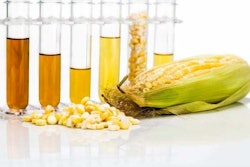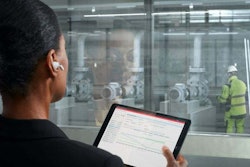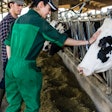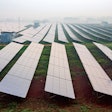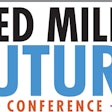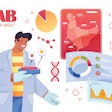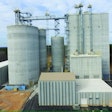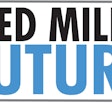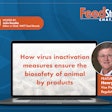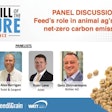
What food production stakeholders are doing across the supply chain to lower GHG emissions
In order to prevent the worst effects of climate change from happening, the global temperature cannot increase more than 1.5 degrees C above pre-industrial levels. With the global temperature already 1.1 degrees C warmer than it was in the late 19thcentury, greenhouse gas (GHG) emissions must be reduced by 45% by 2030 and reach net-zero by 2050 to stay below the 1.5 degree C threshold, according to theNet-zero Coalition.
In broad terms, reaching net-zero means negating GHG emissions produced by human activity to as close to zero as possible, with any remaining emissions re-absorbing into the atmosphere, oceans and forests.
Deriving more energy from renewable sources like wind and solar have the greatest potential for reducing GHG emissions worldwide, however, achieving net-zero by 2050 will require more than green energy solutions. It’ll take global transformation of the way all people and sectors produce, consume and move about the world.
National and local governments have set off the transformation with more than 70 nations, including the United States, the European Union and China, setting net-zero by 2050 targets. And more than 1,000 cities, 1,000 educational institutions and more than 400 financial institutions have joined theRace to Zero, which pledges to take action to cut global emissions in half by 2030.
Meanwhile, more than3,000 businessesare working with theScience-Based TargetsInitiative to reduce their GHG emissions in line with climate science. These corporate commitments are driving the feed industry’s need to engage in the sustainability space.
Climate change mitigation commitments on the rise
According to theScience-Based Targetsdatabase, more than 85 food and agriculture producers and nearly 300 food and beverage processing companies worldwide have established near- or long-term climate change mitigation commitments.
These commitments require companies not only to assess their upstream sources’ carbon footprints, but also their sources’ carbon footprints, throughout all potential stakeholders in their supply chain, to fully understand their footprint.
This is known as alife cycle assessment (LCA)—a critical tool for measuring the environmental footprint of all products along the value chain and used by companies to establish carbon emissions targets.
For animal protein production, feed represents about 40% to 80% of the GHG emissions, or carbon footprint, linked to an animal’s lifecycle.
“That’s why, in recent years, there has been a growing focus on feed’s footprint and how we can reduce that,” Lara Moody, executive director of theInstitute for Feed Education and Research (IFEEDER), said in a webinar announcing the launch ofIFEEDER’s Sustainability Toolkit. “There are a lot of consumer product goods (CPG) companies, or downstream customers of ours, that are placing goals and targets around net-zero and carbon neutral anywhere from the next 10 to 30 years out.”
Making sustainability progress across the supply chain
To help food industry stakeholders navigate the next 10 to 30 years of corporate climate pledges,Feed Mill of the Future Conference, held duringIPPE2023, hosted a panel discussion titled, “Feed’s role in animal ag’s path to net-zero carbon emissions.”
Panelists aimed to portray how different roles throughout the value chain, including animal protein producers, animal nutrition providers, feed production equipment suppliers and feed mill builders, all contribute to meeting these corporations’ net-zero commitments.
Marcelo Dalmagro, strategic marketing and technology director for Latam South,Cargill, lent his unique perspective as a Brazilian broiler producer to the panel discussion. In less than 10 years, Dalmagro’s family farm operation grew from 300 broilers per year to 3 million.
“从农民的角度来看,我们正在努力ablish a target at the end of the road that serves as our horizon ahead,” Dalmagro said. “But after starting an LCA exercise in our operation, we understood that GHG emissions were a very small part of what we could do for sustainability.”
The LCA helped Dalmagro’s operation identify four sustainability objectives: improve water and energy efficiency, improve waste management, improve broiler production efficiency, and improve the livelihoods of the people at the farm.
“We put those four objectives beside our mission statement as the target for us as a farm,” Dalmagro said. “We decided not to set very long-term objectives but look at actions we could accomplish in the short term. By accomplishing those in the short term, we will gain the confidence in ourselves to improve and invest in the future.”
From the nutrition perspective, Ryan Lane, president ofADM Animal Nutrition North America, said in the panel discussion that balancing affordability and marketability with the sustainability of a feed ingredient, likesingle-cell proteins, is a priority for ADM.
“我们一直在使用单细胞蛋白ver — yeast fermentation, biomasses, etc.,” Lane said. “When I first got into the feed industry, algae for renewable fuel was very important so, as a nutritionist, I asked, ‘Can I have a kg of that algal biomass?’ And they said, ‘Yeah, for $10,000.’ You’ve got to look at the economies of scale, and most likely, it doesn’t have the right cost structure, the right volume, and it may not be approved for regulatory use. But if we answer yes to those three major issues for a new ingredient — single cell or upcycling raw material — we’ll put it in production.”
Meanwhile, panelist Gero Zimmermann, head of technology, Animal Nutrition forBühler, said not to overlook the feed production process and equipment for opportunities to reduce GHG emissions.
“Considering the fact that feed production accounts for one-third the carbon footprint of the animal protein supply chain and that 96% of this one-third are related to raw materials, one could easily come to the wrong conclusion that not much can be done on the level of the feed mill,” Zimmermann said. “But this is certainly a wrong conclusion.”
Adding digital sensors to manufacturing equipment provides a degree of transparency and insights into the process that skilled operators can use to optimize production settings, improve efficiency and reduce the mill’s carbon footprint.
Then, integrating those sensors with a predictive model and machine learning algorithm, the system and hardware can provide optimization recommendations and a decision support system to run the feed mill at a much higher efficiency than it would without having those systems in place.
“We’ve seen cases in pelleting lines where we installed such systems and the process runs 20% higher throughputs with energy usage down 10% to 20% from before — with a very consistent end-product quality,” Zimmermann said. “For a pelleting line with a yearly production capacity of 100,000 tons, this translates into a 3,000-ton reduction of CO2, and that 3,000-ton reduction will turn into the drawdown capacity of around 130,000 trees. That’s just for one line, so if your factory has a couple of lines, this is quite an achievement and a significant impact on sustainability.”
Alex Kerrigan, vice president – project development forTodd & Sargent, suggested a holistic approach to sustainable feed mill design and construction during the Feed Mill of the Future Conference panel discussion.
在“传感器能将洞察力和数据对此进行ion analysis or when to check the filters or the baghouses, but you really need to focus on the entire operation — the entire feed mill,” Kerrigan said. “You should also get feedback from all sides — fresh eyes can make a big difference. That predictive side doesn’t just need to be sensors. It needs to be the ease of checking equipment and how that will interface with your automation system, as well.”
The path to global net-zero emissions is a journey; it’s not a destination. And the goalposts will keep moving, depending on the expectations of investors, capital resources, consumers and your customers’ customers. When it comes to sustainability in feed, the key is to continually work toward progress.
Feed Mill of the Future Conference was presented by Feed Strategy and Feed & Grain magazines.
IFEEDER launches Animal Food Industry Sustainability Toolkit
The Institute for Feed Education and Research (IFEEDER) launched theAnimal Food Industry Sustainability Toolkitin February 2023. The toolkit, free for allAmerican Feed Industry Association (AFIA)members to access, was designed for the feed and grain oilseed processing sector; feed ingredient manufacturers, including nutrition and health and performance; feed production equipment manufacturers; the pet food industry; and renderers of co-products and byproducts.
Materials in the toolkit include a resource list, the IFEEDER Sustainability Roadmap overview, an animal food sustainability literature database and a glossary of terms.
In a webinar announcing the launch of the toolkit, Lara Moody, IFEEDER’s executive director, said it’s broken into three levels of action to meet users wherever they’re at on their sustainability journey.
“We call it the crawl, walk, run scenario,” Moody said. “That’s getting started, making progress and then reporting on that progress and moving towards targets and goals. Each of our resources are indexed to numbers one through nine on the spectrum of crawl through run. As we created those, it’s not our intention to use them in chronological order, but if you are new to this space, crawl is a good place to start.”
Feed Mill of the Future digital supplement
WATT’s feed brands Feed Strategy and Feed & Grain magazines join forces to launch the monthly Feed Mill of the Future digital supplement. Each edition aims to provide animal feed industry stakeholders with forward-looking content, market insights and a spotlight on the leading-edge technologies shaping the global feed industry of tomorrow.
Subscribe today!https://bit.ly/3dWzow7






